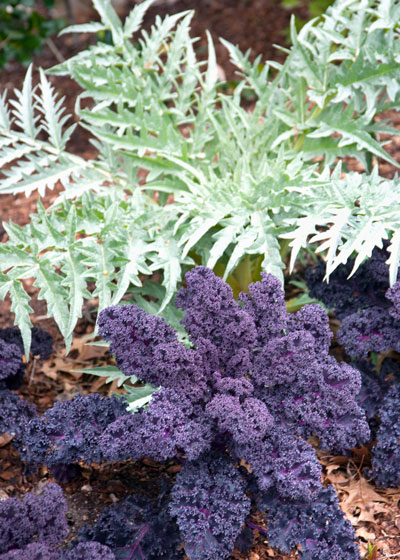Plant of the Week: November 15, 2018 Redbor Kale
You’d almost have to be a visitor from a different planet not to know the health benefits of kale. Vitamins, minerals and disease-fighting antioxidants – the various kales have ‘em all.
We’ve been growing “flowering” kale for decades, so named, I suppose, because those heads look like big roses in shades of pink, white, rose, lavender and green.

Redbor kale and the silvery cardoon draw attention in their planting at the Dallas Arboretum a couple of years ago.
But we’re gathered here today to learn more about a much taller kale called Redbor. This one grows upright to 18 to 22 inches tall and 15 or 18 inches wide. It has much more open growth, and it displays its big, fluffy, crinkly, curly, cool leaves very proudly.
When the seedlings were just getting started in the greenhouses or nurseries back in September, the plants were an odd blending of maroon and green, but as the weather turned colder (as it started doing a week or so ago), the red/purple pigments started to prevail until by Thanksgiving it will be putting on a real show of vivid violet-purple foliage.
Redbor grows tall and open enough that it can become the central axis of your large winter patio pots. Plant contrasting pansies, dusty Miller or sweet alyssum around it. Use it behind any of those plants in floral beds at your home. Add in the dramatic cardoon, as in my photo from a large bed at the Dallas Arboretum. Both cardoon and Redbor grow vigorously, so that tandem isn’t for a tiny little entryway garden in a zero-lot-line community. But where there’s room, it’s a stunning mix.
Nurseries have Redbor as 4-inch, or much better yet, 1-gallon transplants right now. Plant them in full sun and give them 14 or 16 inches between plants. Keep them growing actively by feeding them with high-nitrogen, water-soluble plant food every week.
It’s unlikely that cabbage loopers will visit your plants this winter, but keep your eyes open for holes in the leaves. The small caterpillars feed on all members of the cabbage family, kale included. Bacillus thuringiensis is the only reliable control short of picking them off by hand. Aphids may show up late in the winter. They can be blasted off with a hard stream of water, or most organic or inorganic insecticides will eliminate them.
Enjoy your Redbor kale this winter. I believe you’ll make a new friend. And if you’re craving some nutrients, pinch off a piece of the new growth and use it to embellish a salad.
